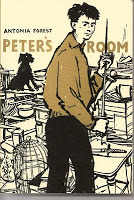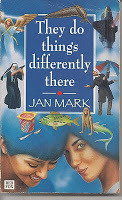Self-created fantasy worlds
Many children and teenagers develop their own private fantasy worlds. I had one. Age nine, I was the imaginary leader of the red horses of the sunset clouds... my name: ‘Red-Gold’. My friend was the leader of the white summer clouds (‘Cloud’); our adversary, the black horses of the thunder. It was obvious enough (you can tell I was horse mad!) but it gave me much pleasure and sent me off to sleep composing adventures. For a feel for the intensity of the thing, here’s a prose poem I wrote about it when I was just thirteen:
And out of the mist come horses galloping, born of the wind with wings like to it, dancing and running, plunging through the cool air, out of the golden, out of the glory, straight from the sun as it shines through the mist: dazzling, glorious, horses of the morning, horses of the sunrise, horses of the dawning, shining horses of the steel-blue sky.
My head may have been almost literally in the clouds, but I don't believe it did me any harm at all. But here are three interesting books which study the effects of fantasy worlds built by young people, and ask what purposes they serve for good and for ill.
 The first and earliest is ‘Peter’s Room’ by Antonia Forest, published in 1961, part of her series of novels/school stories about the Marlow family which began with ‘Autumn Term’(1948). Forest was a writer who transcended genre, and her well-characterised, insightful stories (now reprinted by Girls Gone By) are well worth attention. In this one, set during the Christmas holidays, the younger Marlows and their friend Patrick begin using an old stable loft (‘Peter’s room’) as their daily meeting-place. Inspired by the Brontë sisters’ Angria and Gondal, they pass the time by inventing an imaginary world with themselves as characters – role-playing, if you like. Gradually, their fantasy characters begin to exert influence on their real lives. It nearly ends in disaster.
The first and earliest is ‘Peter’s Room’ by Antonia Forest, published in 1961, part of her series of novels/school stories about the Marlow family which began with ‘Autumn Term’(1948). Forest was a writer who transcended genre, and her well-characterised, insightful stories (now reprinted by Girls Gone By) are well worth attention. In this one, set during the Christmas holidays, the younger Marlows and their friend Patrick begin using an old stable loft (‘Peter’s room’) as their daily meeting-place. Inspired by the Brontë sisters’ Angria and Gondal, they pass the time by inventing an imaginary world with themselves as characters – role-playing, if you like. Gradually, their fantasy characters begin to exert influence on their real lives. It nearly ends in disaster.Forest was writing with unusual foresight about the seductive power of role-playing (think Second Life) – but also, the book is about the creative process – the way characters develop lives of their own and often take their authors and creators in unexpected directions. When Patrick’s ‘avatar’, the heroic sounding ‘Rupert Almeda’ evolves into a traitor and coward, it throws Patrick himself into existential doubt. Is he too a coward? How much of himself is in Rupert? Who, really, is he? Forest is in no doubt that the process can be extremely dangerous. The reader doesn’t have to follow her all the way. It could be argued that role-playing is (usually) a safe way of exploring the possibilities of individuals and relationships. Just so long as it doesn’t take over…
 A more playful but no less thoughtful exploration of the subject is Jan Mark’s wonderful book “They Do Things Differently There” (1994) in which two bored and lonely teenage girls living in a very ordinary new town called Compton Rosehay, form a friendship by inventing an utterly bizarre alternative neighbourhood called ‘Stalemate’. Local landmarks become ‘Lord Tod’s Corpse Depository’ and ‘The Mermaid Factory:
A more playful but no less thoughtful exploration of the subject is Jan Mark’s wonderful book “They Do Things Differently There” (1994) in which two bored and lonely teenage girls living in a very ordinary new town called Compton Rosehay, form a friendship by inventing an utterly bizarre alternative neighbourhood called ‘Stalemate’. Local landmarks become ‘Lord Tod’s Corpse Depository’ and ‘The Mermaid Factory:“There is a mermaid factory?”
“You know that big iron barn place at the end of Old Compton Street, just opposite the bus stop at the end of the slip road.”
“Where it says O GLEE...?”
“That’s the place.”
“It’s got petrol pumps outside; I think it used to be a garage.”
“You may think so,” said Elaine, “but remember, here in Stalemate what you see is not necessarily what is there. Earth’s fabric hath worn thin. The real Stalemate is all about us, but we only get occasional glimpses of it. You’ll just have to take it on trust. It’s a mermaid factory.”
In this book, the fantasy world the girls create is the basis of the friendship between them. The book’s a celebration of the delights of invention and imagination, and of the joy of finding someone else with the same sense of humour. In the end, though, as the name suggests, you cannot stay in Stalemate. You have to move on.
 The most recent book I know which looks at this subject is “The Traitor Game” (2008) by B.R.Collins. Michael and Francis share an imaginary world called Evgard, involved in bitter civil war, with a city called Arcaster. Michael invented it, and it’s been a refuge from the bullying he endured at his last school. Now Francis has been allowed in.
The most recent book I know which looks at this subject is “The Traitor Game” (2008) by B.R.Collins. Michael and Francis share an imaginary world called Evgard, involved in bitter civil war, with a city called Arcaster. Michael invented it, and it’s been a refuge from the bullying he endured at his last school. Now Francis has been allowed in.There was only one other person who knew where Arcaster was; who even knew it existed: Francis. It was as secret, more secret, than a love affair or a drug habit...
And sometimes… when they worked on something together, and ... when both of them were talking about Evgard, arguing, joking, pushing at each other for ideas, Michael felt like he could stretch out his hand and nearly, nearly feel the world of Evgard beyond the real one... He’d catch Francis’s eye when he looked up from his drawing, or hear him say, ‘No, but no, you couldn’t get from Than’s Lynn to Arcaster in two days, it’s winter, you’d have to go the long way round, via Gandet and Hyps,’ and suddenly he’d want to grin like an idiot. It was crazy, they were fifteen, for God’s sake, it wasn’t like they were kids, but here they were inventing a country.
So when Michael believes Francis has betrayed him, his emotions are catastrophic; and the betrayal occurs in Evgard too. This is a dark unflinching book which delves deep into jealousy, cruelty, anger and fear.
All three of these very different books are powerful explorations of friendship and selfhood, and the dark as well as the joyful side of the impulse to create.
Published on March 13, 2014 13:54
No comments have been added yet.



